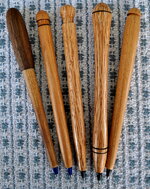monophoto
Member
I know that many pen turners make 'cheap pens' using refills from inexpensive ball point pens that are sold in quantities at big box and 'dollar' stores (note that I am trying to avoid using an commercial brand names here).
Several weeks ago, Brendan Stemp posted a very helpful video on his method for making these pens. In that video, he demonstrated three things that I had not seen anywhere else.
The first was that rather than holding the blank in a chuck for drilling, he started with a blank that was a couple of inches longer than the final pen, and turned a crude morse taper on the end. Then, he simply pushed the blank into the morse taper in his headstock. I'm fortunate to have a chuck that I can use, but his technique is an option for those who don't have a chuck.
Sometimes the 5/32" hole in the barrel is too large, and the refill won't stay in the hole. Brendan solved that by wrapping the refill with a couple of turns of ordinary teflon plumber's tape.
The third new thing he did was to drill a very small breather hole in the side of the finished pen. I can certainly understand the theory behind this hole - as ink is used, there will be a tendency for a vacuum to form inside the ball point refill tube that will eventually strangle the flow of ink. Having a breather hole makes it possible for air to enter the barrel of the pen to equalize the pressure and keep the ink flowing.
But that begs the question that factory-made pens don't have a breather - so why is it necessary for us to drill one when we make pens from wood? I suspect the answer is that plastic nib on the refill has small deformations around its circumference that provide minute breather channels around the nib when it is used in a plastic barrel. Because wood can compress, those deformations could press into the wood, reducing the size of the breather channels when it is inserted into a wooden barrel. And if teflon tape is used to pad out the diameter of the refill, then it will also obstruct that breather channel.
But that raises the question - how many pen turners who make these cheap pens drill a breather hole in the barrel?
Several weeks ago, Brendan Stemp posted a very helpful video on his method for making these pens. In that video, he demonstrated three things that I had not seen anywhere else.
The first was that rather than holding the blank in a chuck for drilling, he started with a blank that was a couple of inches longer than the final pen, and turned a crude morse taper on the end. Then, he simply pushed the blank into the morse taper in his headstock. I'm fortunate to have a chuck that I can use, but his technique is an option for those who don't have a chuck.
Sometimes the 5/32" hole in the barrel is too large, and the refill won't stay in the hole. Brendan solved that by wrapping the refill with a couple of turns of ordinary teflon plumber's tape.
The third new thing he did was to drill a very small breather hole in the side of the finished pen. I can certainly understand the theory behind this hole - as ink is used, there will be a tendency for a vacuum to form inside the ball point refill tube that will eventually strangle the flow of ink. Having a breather hole makes it possible for air to enter the barrel of the pen to equalize the pressure and keep the ink flowing.
But that begs the question that factory-made pens don't have a breather - so why is it necessary for us to drill one when we make pens from wood? I suspect the answer is that plastic nib on the refill has small deformations around its circumference that provide minute breather channels around the nib when it is used in a plastic barrel. Because wood can compress, those deformations could press into the wood, reducing the size of the breather channels when it is inserted into a wooden barrel. And if teflon tape is used to pad out the diameter of the refill, then it will also obstruct that breather channel.
But that raises the question - how many pen turners who make these cheap pens drill a breather hole in the barrel?

